Recently, I posted on Facebook a photo Chiara Boschis sent me of her mother with Maria and Cesare Borgogno. Oh how I wish I had had that photo for my book, Labor of Love: Wine Family Women of Piemonte.
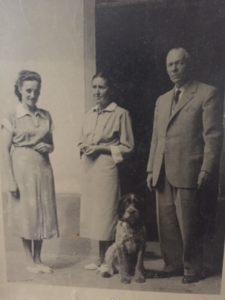
But despite not having the photo, I did get to write the story the photo tells thanks to Chiara’s generosity with her time and memories.
Here’s an excerpt about the connection between the Franco Boschis and the historic Borgogno families, and how it came to be, from Chapter 2 — Boschis — of Labor of Love. (Note: WordPress has it’s own mind about hyphenation. Not as it was originally in the book).
But first, to provide readers with a roadmap of the family — an idea of my editor, Elatia Harris, and something lovers of the stories repeatedly thank me for — the genealogy of the Boschis family.
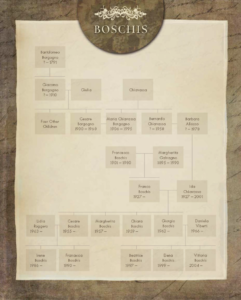
I had already discovered it was impossible to talk about recent history in Piemonte without World War II figuring large. In 1943, before the German occupation of Piemonte, Chiara’s mother, Ida Chiavassa, bicycled from her home in Bra, south across the Tanaro River, to Barolo to visit her paternal aunt, Maria Chiavassa Borgogno, the wife of the winemaker Cesare Borgogno. As she proceeded along the journey, with steep inclines and twisting roads, the closer she got to her aunt and uncle’s estate, the angrier she became. It was common in those days for young girls to help wealthy relatives in their homes. The 16-year-old was not at all happy about the prospects of leaving her home, her sisters, her friends, and, most of all, her first love. Little did Ida know, the long bike ride led to something much more enduring than long hours of work and loneliness.
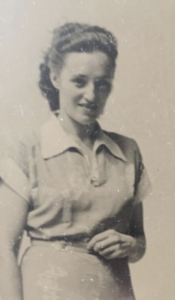
After the Germans occupied Piemonte, the Allies began to bomb the region. Travel across the Tanaro River became dangerous, so Ida remained in Barolo. And she never returned to Bra, not for good. Shortly after Ida arrived, a young man who had experienced his own disappoint-ments in life began working for the Borgognos. The times were tough economically and had dashed Franco Boschis’s dream of oenological school. He had to go to work. Fate took him to Borgogno.
Franco was delighted to see someone his age at the winery, particularly a pretty young woman. Ida, still fuming about her fate, paid no attention to the handsome young man. But as time passed, and more men left for war, then to the cities afterward, they became friends. In time, a romance blossomed and Ida and Franco married. Chiara told me, “My football-playing father claims it was his ‘nice legs’ that she first noticed.” Whatever it was, as soon as Ida turned her back on Bra, a future in Barolo materialized. That future involved wine and a daughter who would become world-renowned for her oenological prowess.
Ida’s uncle Cesare was the seventh generation of the Borgogno family to own and operate the historic winery, founded in 1761, on the outskirts of Barolo. Cesare’s acquisition of the winery deviated from the usual patriarchal inheritance, with the firstborn male inheriting the family’s property. Born in 1900, Cesare was the youngest child and third son of Giacomo and Giulia Borgogno. In Cesare’s 11th year of life, his father died. His elder brothers lacked interest in the wine business, but one of them helped his mother run the winery until Cesare assumed its management nine years later. His wife, Ida’s aunt, and Chiara’s great aunt, Maria Chiavassa Borgogno, took the traditional women’s task of working behind the scenes in the winery.
Chiara then told me a story that defined her uncle. I was riveted to learn about Cesare Borgogno and his 1935 vintage Barolo. In 1944, during the occupation, the Germans and their equally brutal Fascist allies terrorized — I use the word advisedly — the population of Piemonte. On June 30, 1944, three trucks filled with German soldiers lost their way to Bra. They mistakenly took the road to Barolo and stopped near the Borgogno estate. A group of partisan resistance fighters spotted the trucks, shot at and wounded several German soldiers, and vanished into the countryside. The Germans retreated, but only after driving into Barolo to open fire on the castle and on homes throughout the village. Fortunately, the locals had run for cover.
Two days later in a convoy of trucks and armored cars, the Germans returned and charged the Borgogno family with complicity in the partisans’ attack. It took them very little time to root out the entire 1935 vintage — 240 large wooden crates of 50 bottles each, cached mostly at Cantina Canonica. Only one crate was hidden at the Borgogno estate.
It was well known that throughout occupied wine regions across Europe, German soldiers would plant evidence in cellars as a pretext for confiscating wine as spoils of war. The Germans claimed to have found a gun in the cellar of the Borgogno winery and helped them-selves to copious amount of Barolo, breaking everyone’s heart at the mistreatment of so precious a wine. The entire vintage went to Turin with the Germans.
Accompanied by the pastor of the Catholic Church in Barolo, Cesare left for Turin, the German headquarters, in hopes of retrieving his wine. On the way to the city, Cesare and the priest stopped at the Lancia automobile factory in Chivasso to enlist the help of a former client of Cesare’s. Wine lover Giorgio Eggstein was no Nazi, but he held a position of authority in the German army. Eggstein accompanied the priest and winemaker to Turin. While there, Cesare encountered young male prisoners from Barolo accused of being partisans and destined for German work camps. It was a fate tanta-mount to a death sentence. Believing Cesare had come to their rescue, the prisoners rejoiced. But Cesare had come to save wine, not people. The commandant declared the wines were confiscated as spoils of war, not stolen booty as Cesare claimed. He offered Cesare a solution.
He would impose a tax on all of Barolo’s inhabitants in exchange for the wines. Cesare refused. Instead, rising to the full implications of the crisis, he bargained for the prisoners in exchange for the wine. The commandant agreed. An entire vintage in return for a few young lives — Cesare saw the right thing to do, and did it.
Cancer robbed Barolo of Cesare Borgogno in 1968. His marriage to Maria Chiavassa produced no male heirs, so Maria and Cesare’s niece Ida, and her husband, Franco Boschis, assumed control of the winery, continuing the Borgogno family ownership. Over time, Franco and Ida’s sons Cesare and Giorgio joined their parents at Borgogno. The Boschis family eventually bought out the other ownership interests in the winery and began much-needed improvements to compete with the burgeoning number of new Barolo wineries. In 2008, Franco and Ida sold Borgogno to the epicurean entrepreneur Oscar Farinetti and his son, Francesco, ending generations of family ownership. The famed winery would endure, but in the hands of another family.
Meanwhile, Chiara Boschis had come of age.
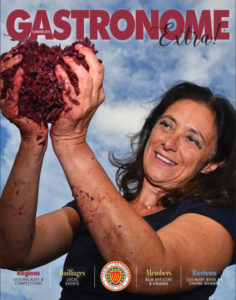
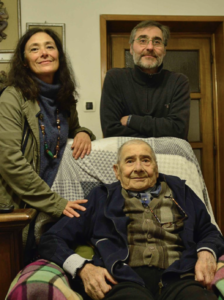
Personally inscribed and signed copies of my award-winning book, Labor of Love: Wine Family Women of Piemonte, that explores the life and times of 22 Piemontese wine families can be found on this website. The book is also available on Amazon.